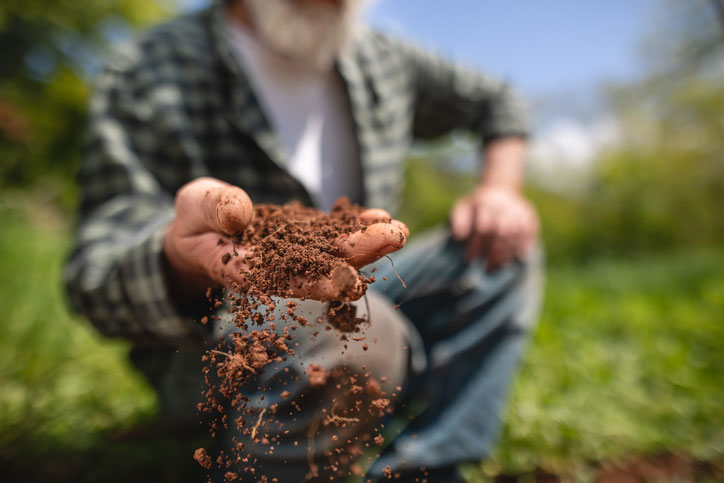Although we often interchange the words "dirt" and "soil," they aren’t the same thing. We found a great explanation from Soil Science Society of America:
“Soil is alive with living organisms such as worms, fungi, insects, bacteria, and organic matter. It supports life with its naturally occurring nutrients and minerals, making it a perfect planting medium. It is a complete and self-sustaining ecosystem.” On the other hand, dirt is “displaced soil.” Once soil is displaced, it breaks up the ecosystem and becomes the annoying dirt we wash off our gloves and out of our clothes.
So, let’s talk soil.
We often tell you to mulch, mulch, mulch. Mulching protects the soil ecosystem that provides a healthy habitat for our plants. Mulch protects the organisms as well as the roots from the harsh environment, whether the August heat or the third week of January cold.
For instance, after a heavy dew or rain, earthworms (nature's soil rototiller) will rise to the top of the soil. Mulch works as their umbrella so they aren’t baked from the sun the next afternoon. It also works as a barrier to control temperatures — as best it can in Central Texas. Think of the insulated bags we use to bring groceries home from the store. The bag helps maintain the needed temperature for your food. Mulch will also break down into organic matter, thus the need to continuously add more.
Gentle reminder: Since mulch does such a great job of creating a sustainable habitat for bugs, always leave a 6-inch ring of un-mulched area around your trees. Some bugs we don’t want so cozy with our trees.
Our plants need nutrients in their most basic form. For instance, nitrogen is essential for chlorophyll and cell formation of plants. Oxygen is needed for respiration and energy production. Microbes eat and digest organic matter in our gardens, flowerbeds, fields, and pastures. The eating and digesting results in nutrients in their basic form. Microbes, microorganisms such as fungi and bacteria, are citizens of our soil ecosystem. During certain times of the seasons, we will advise to add organic matter to your gardens. This action feeds the microbes, which, in turn, feed our plants. It’s a wonderful circle.
JANUARY GARDEN DUTIES
1. Now is the time to plant vegetable plants: artichoke crowns, asparagus crowns, broccoli, cabbage, lettuce and spinach. We can still plant strawberries and herbs such as chervil, chives, cilantro, oregano, parsley, rosemary, sage, and thyme. Start selecting onion sets and get them into the ground. There are many varieties these days, so take your time in your final selection.
2. In the flower department, plant sweet alyssum, ornamental cabbage and kale, Johnny jump-ups, pansy (faceless are my favorites), snapdragons, violas, and stock.
3. If you are blessed enough to have a greenhouse or cold flats, start tomato seeds indoors.
4. Good time to check out (and repair, if necessary) your irrigation system. Also, it’s an excellent time to design your system for this spring.
5. On those cold and rainy days, it is best to work inside. Wonderful opportunity to clean and oil our gardening tools.
6. Mulch, mulch, and more mulch is the byword for the winter.
7. Fertilize your established pansies with dried blood meal or cottonseed meal at the rate of 3-4 pounds per 100 square feet of flowerbed.
8. With the heavy dew and light rains, keep an eye on your bird feeders. You want to make sure you don’t allow the bird seed to mold. Moldy seed can make birds sick. Be kind to your backyard buddies.
Until next time, keep your souls and soles in your garden! Remember the True Master Gardener: Jesus said, “I am the vine; my Father is the Gardener.” John 15:1
Contact Bill Luedecke at The Luedecke Group Realtors at 512-577-1463 or email him at bill@texasland.net. Contact Martelle Luedecke at 512-769-3179 or luedeckephotography@gmail.com.

